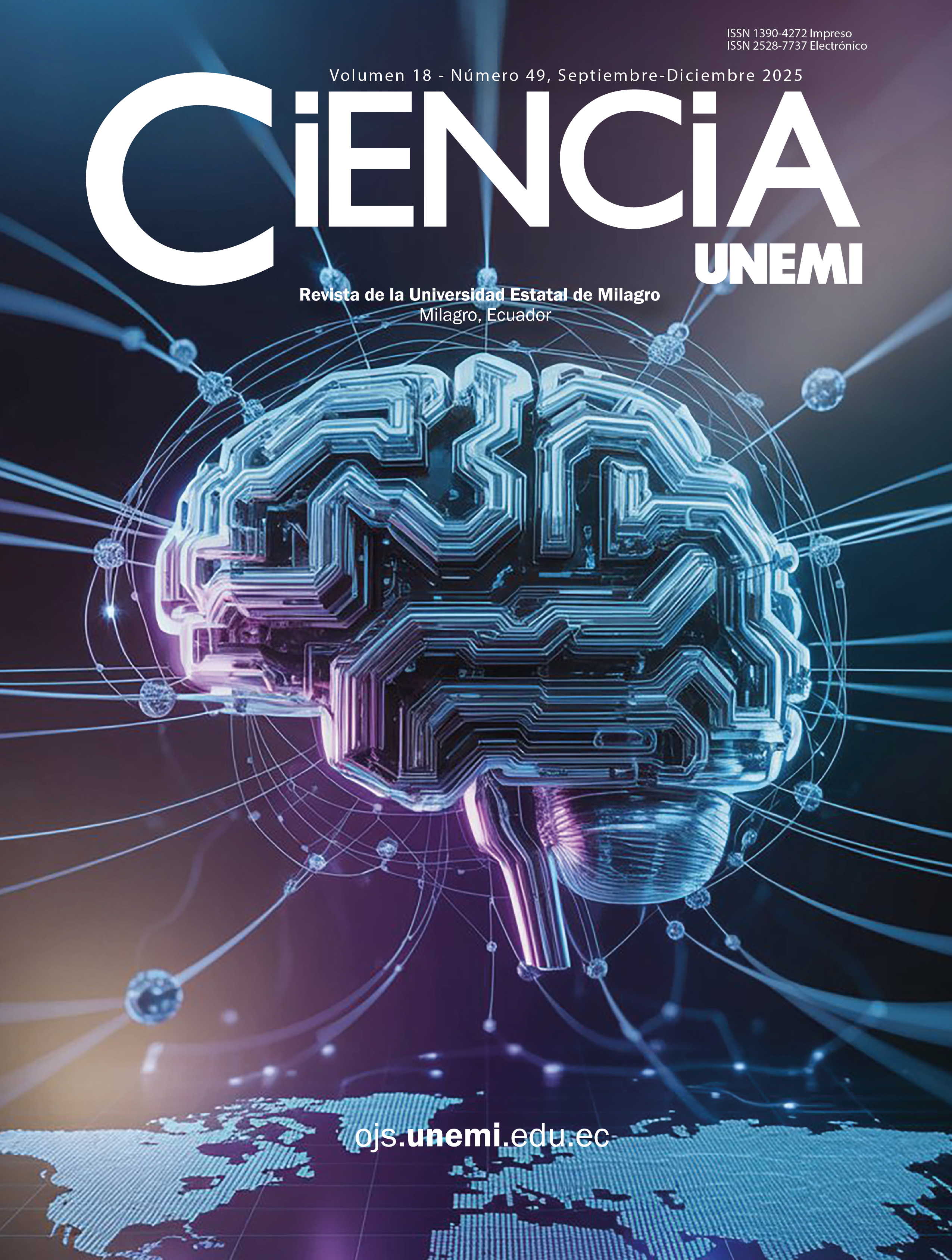Short review: genetic improvement in animal species using embryo transfer technology (ETT)
DOI:
https://doi.org/10.29076/issn.2528-7737vol18iss49.2025pp185-189pKeywords:
Genetic improvement, animal species , ETTAbstract
The sustained increase in agri-productive demands associated with population growth has driven the development and application of reproductive biotechnologies in the livestock sector. Among these, genetic improvement in animal species has become a fundamental strategy, with embryo transfer standing out as one of the most effective techniques in cattle, swine, and sheep. This biotechnology enables the accelerated multiplication of elite females’ genetic merit, optimizing reproductive efficiency and expediting genetic progress within herds. As a result, the phenotypic and productive quality of livestock is enhanced, contributing to the strengthening of global livestock competitiveness
Downloads
References
Araújo, F. R., & Tonhati, H. (2016). Genetic improvement in pigs in Latin America. Revista Brasileira de Zootecnia, 45(12): 835-843. DOI: 10.1590/S1806-92902016001200007.
Barros-Delgadillo, JC, & Castillo-Ruiz, AK. (2017). Resultados de los ciclos con transferencia de embriones desvitrificados: experiencia institucional de seis años. Ginecología y obstetricia de México, 85(7), 421-432. http://www.scielo.org.mx/scielo.php?script=sci_arttext&pid=S0300-90412017000700421&lng=es&tlng=es.
Bruno-Galarraga, M.M., Cueto, M., Gibbons, A.E., Pereyra-Bonnet, F., Catalano, R., González, B. (2014). Repeatability od superovulatory response to successive FSH treatments in Merino sheep. Small Ruminant Research. 120 (1), 84-89. DOI: 10.106/j.smallrumres.2014.04.002.
Cruz-Coke, M.R. (2003). Valoración de trabajos clásicos en la historia de la genética. Revista médica de Chile, 131(2): 220-224. https://dx.doi.org/10.4067/S0034-98872003000200014
Falk, R. (2010). Mendel's legacy: The origins of classical genetics. Cold Spring Harbor Perspectives in Biology, 2(4): a000374. DOI: 10.1101/cshperspect.a000374.
Grupen, C.G. (2014). The evolution of porcine embryo in vitro production. Theriogenology 2014;(81): 24-37. https://pubmed.ncbi.nlm.nih.gov/24274407/.
IHGSC (2021). International Human Genome Sequencing Consortium. Initial sequencing and analysis of the human genome. Nature, 409 (6822): 860-921. DOI: 10.1038/35057062.
Lenis Sanin, Y., Carrillo González, D.F., Barrios, D. Rincón, J.C. (2021). Inseminación artificial y liderazgo rural. Editorial, Universidad Nacional de Colombia. Colecciones Sede Palmira. pp 76. https://repositorio.unal.edu.co/handle/unal/81417.
Mancias Andrade, O.V. (2020). Producción in vitro y transferencia de embriones
porcinos: Revisión de Literatura. Escuela Agrícola Panamericana, Zamorano
Honduras, 1.28. https://bdigital.zamorano.edu/items/1fae2e9c-e28e-446b-b8ab-bd402707efd6
Marizancén Silva, M. A., & Artunduaga Pimentel, L. (2017). Mejoramiento genético en bovinos a través de la inseminación artificial y la inseminación artificial a tiempo fijo. Revista De Investigación Agraria Y Ambiental, 8(2), 247–259. https://doi.org/10.22490/21456453.2050.
Martínez-Rojero, R., Mejía-Villanueva, O., Zarco-Quintero, L., Mastache-Lagunas, A., Reyna-Santamaría, L. (2017). Evaluación de un protocolo de superovulación para transferencia de embriones en ovejas Criollas de la Montaña de Guerrero. Abanico veterinario, 7(3): 30-36. https://doi.org/10.21929/abavet2017.73.3
Mucci, N., Aller, J.F., Kaiser, G.G., Hozbor, F., Alberio, R.H. (2006). Producción in vitro de embriones bovinos: suplementación de los medios de cultivo con suero. Archivos de Medicina Veterinaria. 38(2): 97-104. https://www.scielo.cl/scielo.php?pid=S0301-732X2006000200002&script=sci_arttext
Piñeira, J., Riveros, J.L., Felmer, R. (2009). Herramientas de última generación para mejoramiento genético animal, INIA Tierra Adentro, mayo junio: 42-45. https://inia.uy/proyectos/herramientas-para-incrementar-el-mejoramiento-genetico-animal.
Revidatti, M. A., & Pinto, L. F. B. (2017). Animal breeding in Latin America: Current status and future perspectives. Frontiers in Genetics, 8, 196. DOI: 10.3389/fgene.2017.00196.
Salamanca Gómez, F. (2004). III. Nature, 25 de abril de 1953. Gaceta médica de México, 140 (2), 246-250. http://www.scielo.org.mx/scielo.php?script=sci_arttext&pid=S0016-38132004000200029&lng=es&tlng=es.
Sanoja Breña, A. (2016). Doble transferencia embrionaria consecutiva D3/D5-6: una alternativa para mejorar las tasas de embarazo en pacientes sometidas a fertilización in vitro/transferencia embrionaria (FIV/TE). Revista de Obstetricia y Ginecología de Venezuela, 76(4), 266-276. http://ve.scielo.org/scielo.php?script=sci_arttext&pid=S0048-77322016000400006&lng=es&tlng=es.
Tocarruncho Cely, F. A. (2015). Superovulación y transferencia de embriones en bovinos. pp 34. https://ciencia.lasalle.edu.co/medicina_veterinaria/372
Urbán Duarte, D., Álvarez Gallardo, H., Pérez Reynozo, S., & Torre Sánchez, J. F. (2020). Producción in vitro de embriones porcinos con el uso de un sistema de medios de cultivo químicamente semi-definidos. Revista mexicana de ciencias pecuarias, 11(1): 102-115. https://doi.org/10.22319/rmcp.v11i1.4757
Whitelaw, C. B., Sheets, T. P., & Lillico, S. G. (2015). Engineering animal genomes: Progress and prospects. Journal of Animal Science, 93(1), 28-35
Wray-Cahen, D., Bodnar, A., Rexroad, C. et al. (2022)Advancing genome editing to improve the sustainability and resiliency of animal agriculture. CABI Agric Biosci 3, 21. https://doi.org/10.1186/s43170-022-00091-w.
Yoon KW, Shin TY, Park JI, Roh S, Lim J, Lee BC, Hwang WS, Lee ES. 2000. Development of porcine oocytes from preovulatory follicles of different sizes after maturation in media supplemented with follicular fluids. Reproduction, Fertility and Development, 12:133–139. Doi: https://doi.org/10.1071/rd00027
Downloads
Published
Issue
Section
License
Copyright (c) 2025 CIENCIA UNEMI

This work is licensed under a Creative Commons Attribution-NonCommercial-NoDerivatives 4.0 International License.
Authors can keep the copyright, granting the journal right of first publication. Alternatively, authors can transfer copyright to the journal, which allow authors non-commercial use of the work, including the right to place it in a file open access.
















